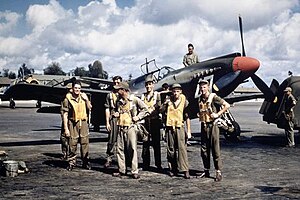North American A-36
| A-36 Apache/Invader | |
|---|---|
 |
|
| North American A-36A | |
| Role | Ground-attack/dive bomber |
| Manufacturer | North American Aviation |
| Designer | Edgar Schmued |
| First flight | October 1942 |
| Introduction | 1942 |
| Retired | 1945 |
| Primary users |
United States Army Air Forces Civilian air racer |
| Number built | 500 |
| Unit cost |
$49,000
|
| Developed from | P-51 Mustang |
The North American A-36 Apache (listed in some sources as "Invader", but also called Mustang) was the ground-attack/dive bomber version of the North American P-51 Mustang, from which it could be distinguished by the presence of rectangular, slatted dive brakes above and below the wings. A total of 500 A-36 dive bombers served in North Africa, the Mediterranean, Italy and the China-Burma-India theater during World War II before being withdrawn from operational use in 1944.
With the introduction of the North American Mustang I with the RAF Army Co-operation Squadrons in February 1942, the new fighter began combat missions as a low-altitude reconnaissance and ground-support aircraft. Supplementing the Curtiss P-40 Tomahawks already in service, Mustang Is were first supplied to No. 26 Squadron RAF, then rapidly deployed to 10 additional squadrons by June 1942. First used in combat over the Dieppe Raid on 19 August 1942, a Mustang of No. 414 (RCAF) Squadron downed one of the formidable Focke-Wulf Fw 190s, the first victory for a Mustang. Despite the limited high-altitude performance of the Allison V-1710 engine, the RAF was enthusiastic about its new mount, which "performed magnificently".
During the Mustang I's successful combat initiation, North American's president Howard "Dutch" Kindelberger pressed the newly redesignated U.S. Army Air Forces (USAAF) for a fighter contract for the essentially similar P-51, 93 of which had passed into the USAAF when the Lend-Lease contract with Britain ran out of funds. The Mustang IA/P-51 used four 20 mm Hispano wing cannon in place of the original armament, a combination of four wing-mounted .30 caliber (7.62 mm) M1919 Browning machine guns and four .50 caliber (12.7 mm) M2 Browning machine guns, two of which were mounted in the wings, while the second pair was mounted in the "chin", or lower engine cowling, and synchronized to fire through the propeller. No funds were available for new fighter contracts in fiscal year 1942, but General Oliver P. Echols and Fighter Project Officer Benjamin S. Kelsey wanted to ensure that the P-51 remained in production.
...
Wikipedia
